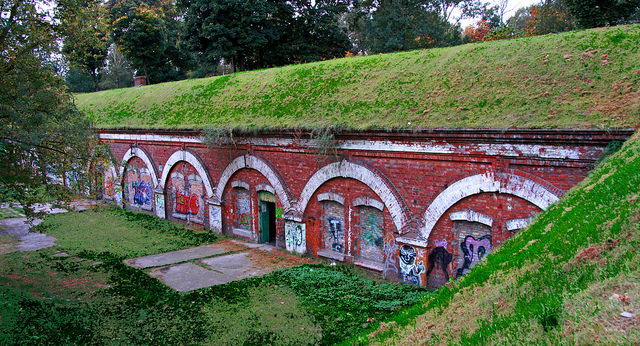Warsaw Fortress was is a group name given to a system of fortifications built in and around the Polish capital. They were all constructed during the time when the city was part of the Russian Empire. In the 19th century, Warsaw was part of what was known as Congress Poland, or Russian Poland. Most of the fortifications were inside the territory of Congress Poland, but there were also a few slightly outside of it’s borders.

The first piece of the Warsaw Fortress was constructed shortly after the November Uprising, also known as the Polish-Russian War (1830-1831), which was a rebellion against the Russian Empire. The uprising started off well and had local success that lasted a short while, until the Imperial Russian Army arrived and crushed it.
The aftermath resulted in a decree signed by the Russian Tsar, Nicholas I, that declared Poland as an integral part of the Russian Empire. And so the first piece of the fortification puzzle was placed; the Warsaw Citadel, built between 1832 and 1834.

For the following forty years the Russian Empire continued to build big castles, barracks, and more forts around Warsaw to reinforce its claim on the Polish territory. In 1874 the puzzle seemed finished and the Russian Empire gave a rest to it’s builders in Warsaw that lasted for 3 years. The machine was started once more in 1879 with a new, much bigger operation. This project would lay out a system of large forts surrounding the city of Warsaw. Thus, 20 more forts circling the city and guarding vital entrances and other strategic points were constructed in a very short period of time, between 1883 and 1890.


The craziest idea in this obsessive megalomania was probably the plan to combine and connect the Warsaw Fortress with the Modlin Fortress, which is around 31 miles north of Warsaw. But both of the main fortresses were on the banks of the Wisla River, so the idea, in theory, seemed really good. However, in practice, it proved impossible, or plain undoable at the time. Only a small part of this plan was carried out and a few of the chain fortresses were constructed. The rest of the resources and labor were put into continual strengthening of the many already existing fortresses. With artillery knowledge and siege instruments gaining rapid progress in the military world, the walls had to be reinforced. By the end of this phase, at the very beginning of the 20th century, the fortress counted 29 forts and other major buildings such as the original citadel, command center, and barracks.


The tide shifted after the Russian Empire was defeated in the war against Japan (1904-1905). This was a period when the Russian Empire had to compensate for the hole in the military purse after the loss. As a result of major calculations in military strategy and reevaluation of it’s strategic deployments, it was decided to cut the budget for operating the Warsaw Fortress. So began the era of deconstruction and demolition of the forts.
The work proceeded slowly and by 1913, just before the outbreak of World War I, the decision to demolish the Warsaw Fortress was reversed. All of a sudden the army was swiftly trying to repair and reinforce all of the damage they themselves had done, in order to make the fortress strong once again and ready to defend the city of Warsaw.

After the First World War, Poland regained it’s independence, and with it the dismantling of the forts resumed. Some of them were completely stripped while others were put to use by the Polish Army as barracks or as a storage site. Over the years all of them were slowly abandoned, and much of what remained of the fortifications was further demolished during the siege of Warsaw in September 1939.

Today many of the forts still stand shaped by time and history. Some are lost, completely dismantled or built over. Most of the remaining ones have no public use, and are closed for visitors, left slowly to decay until they are needed again. Only one fort breaks out of the norm. It was abandoned, and still is in some way, but it is used as an open art gallery. Artists are invited to come and put their mark inside the walls of the old fort.
